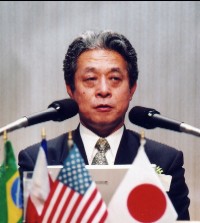Environment Management
May19,2004
Mr.Kazuya Koujitaani
Manager of the Environment Management Department of Kokuyo��Ltd.
 Mr. Kazuya Koujitani, Manager of the Environment Management Department of
Mr. Kazuya Koujitani, Manager of the Environment Management Department of
��okuyo Ltd. spoke on Environment Management at the meeting of May 19: There are 4 issues on which companies must respond today, and they are 1.Sustainable development 2.Company evaluation today is not limited to financial record, but also involves non-financial matters such as its approach to the environment and society. Third, Management��s response to social and community responsibility, and 4.It��s involvement with the environment where a full disclosure is necessary.
For 1., a company engages in business activities seeking profits. The results are reported at stockholders�� meetings. But the public also wishes to know how such business activities have been conducted lessen the effects on the environment. This becomes an important element in deciding on the price of the company��s shares.
For global warming, it is said that the 20th century paid no attention to this phenomenon, which must now be addressed, and therefore our activities must be sustainable. While restrictions are being relaxed, laws concerning the environment are being more strongly enforced.
Under these circumstances, companies are now positively engaged in attaining the ISO14001 status, which is an international standard for environment management, and working towards an emission zero condition.
ISO14001 was introduced to Japan in 1996. At first there were only 104 cases obtaining this status at first, but by November 2003, this had increased to 13,416. Autonomous organizations are spearheading this drive, and the fact that organs which normally superintend such activities are attaining this status themselves shows that it has come to stay.
The Environment Basic Law was made in 1993, and in 200 the Cycle Type Society Formation Basic Law was enacted. The strengthening of such laws has made us change our business practices.
Over 2800 consumers organizations are now members of the ��Green Purchasing Network�� which purchases merchandise which have not harmed the environment. 268, or almost all of the administrative offices, 2177 firms and 268 private organizations are members. This is a rather unusual organization and by last year it had selected 152 articles in 13 different fields ecological merchandise which has been increased to 400 this April.According to manufacturers, these eco goods now comprise 30% of their total sales.
Items 2 and 3 are in regard to the change in evaluation standards. The Japan Economic Journal publishes a ranking of firms engaged in environmental activities every December. Recently, investors evaluate firms by their approach to environmental problems, and we must take care to see that we are carrying out our social responsibilities.
Item 4 is concerned with disclosure. Information must be disseminated regarding a firm��s involvement with environmental issues, and this is necessary also for the service industries. We must disclose our progress in this field to the consumer which is important to heighten the value of the firm.
At first, our involvement with environment as limited to the manufacturing process but believing that environment management was an important element our management, we used it as a key word in planning, development, sales, purchasing and distribution.
Our firm made an Environment Action Charter in 1993 and have gained results by promoting it, but over and beyond this, speed, quality and a higher level is being required. Thus we decided to enlarge the scope of our environmental activities to include all the firms which comprise our group, setting targets for mid-range and long-range plans.
In 1998 we started by obtaining ISO14001 status for our factories, and the following year did the same for our offices, development department, sales and distribution. The third year we were able to build a centralized control system for our entire business areas.
We also have a tool by which merchandise is checked to see if it conforms with environmental guidelines and therefore all our products have been checked ofr environmental conformity before it reaches you.
On the other hand from the standpoint of a consumer, we are making efforts to purchase material which has been given environmental consideration.
The principle is the 3R (Reduce, Reuse, Recycle) to which we have added a 4th R - Rethink.
In practicing environmental management, it causes expenses. We have introduced a new environmental accounting procedure which calculates the environmental effects of our investments, and the reduction of relevant costs.
Although the figures obtained are not as precise as those for our financial accounting, we are conducting environmental accounting as a way of checking the worthwhileness of our environmental investments.
The practice of environmental management however is meaningless unless our employees put this into practice. We believed that it was necessary to evaluate our employees�� individual efforts and thus introduced a ��Environmental Efforts��. Evaluation which has now been incorporated into Environmental Management program. Targets have been set and methods have been set.
We have, after 5 years, finally reached the stage where environmental management is not anymore something special but normal in our daily routine.
In practice, the important point is how to fuse environment management with conventional management.
In conventional management, a plan is made, checks are made for improvements, and this is the basic rule, and the same stance is necessary for environmental management. I believe that a company must engage in environmental management as a whole while maintaining the motivation of its��employees��